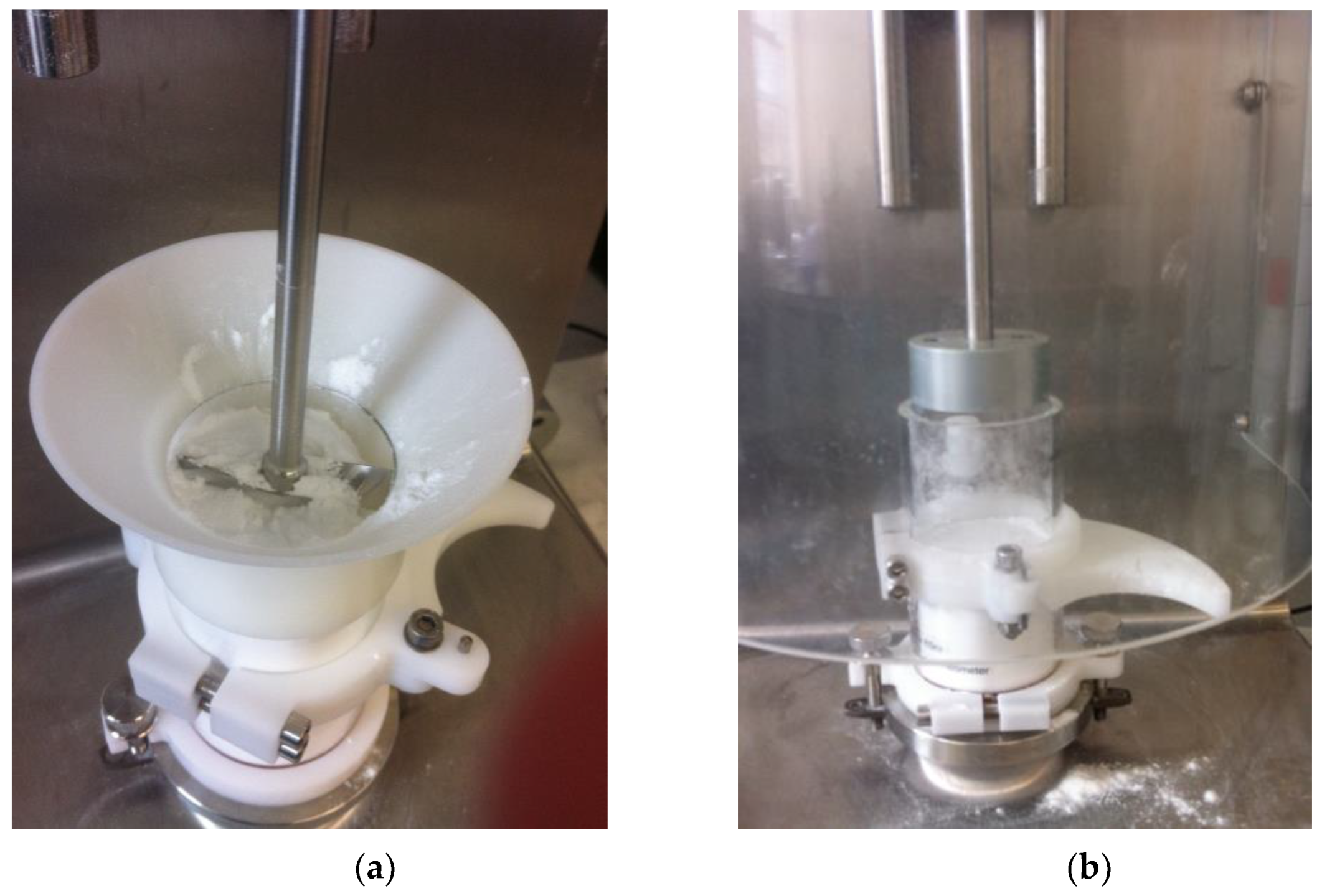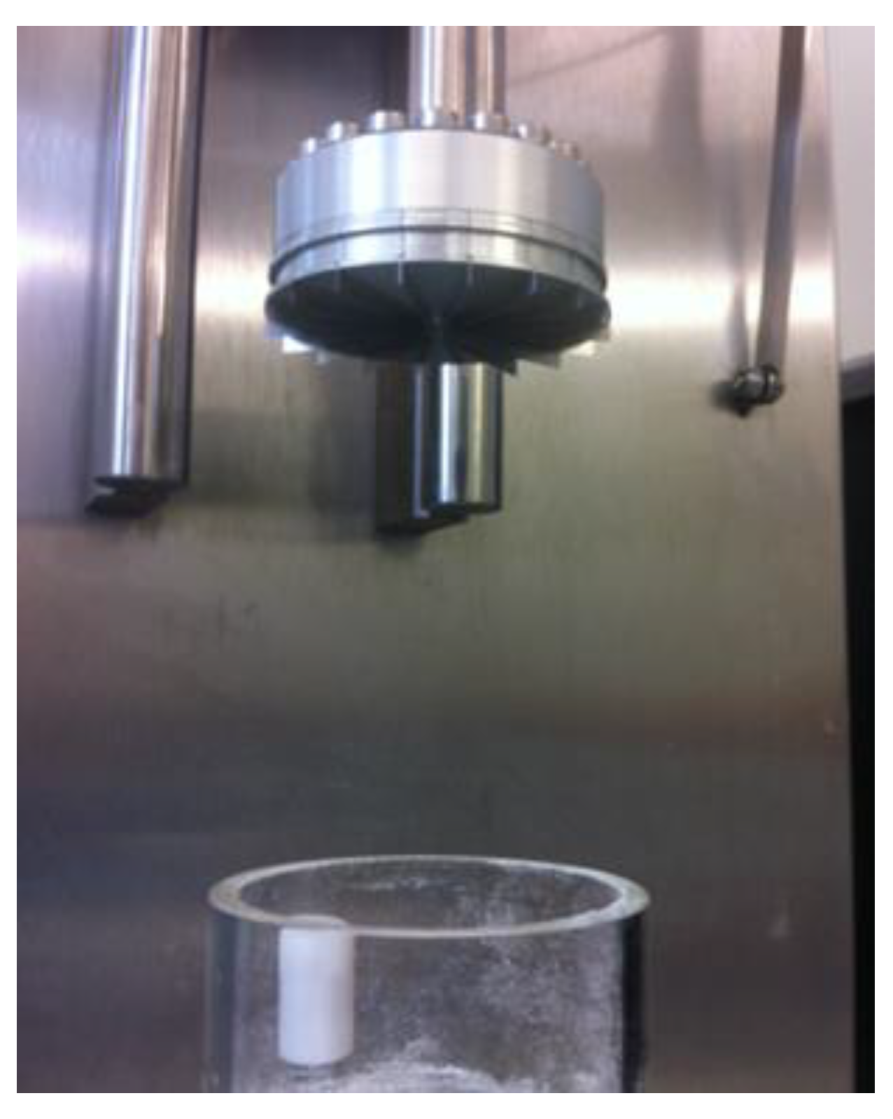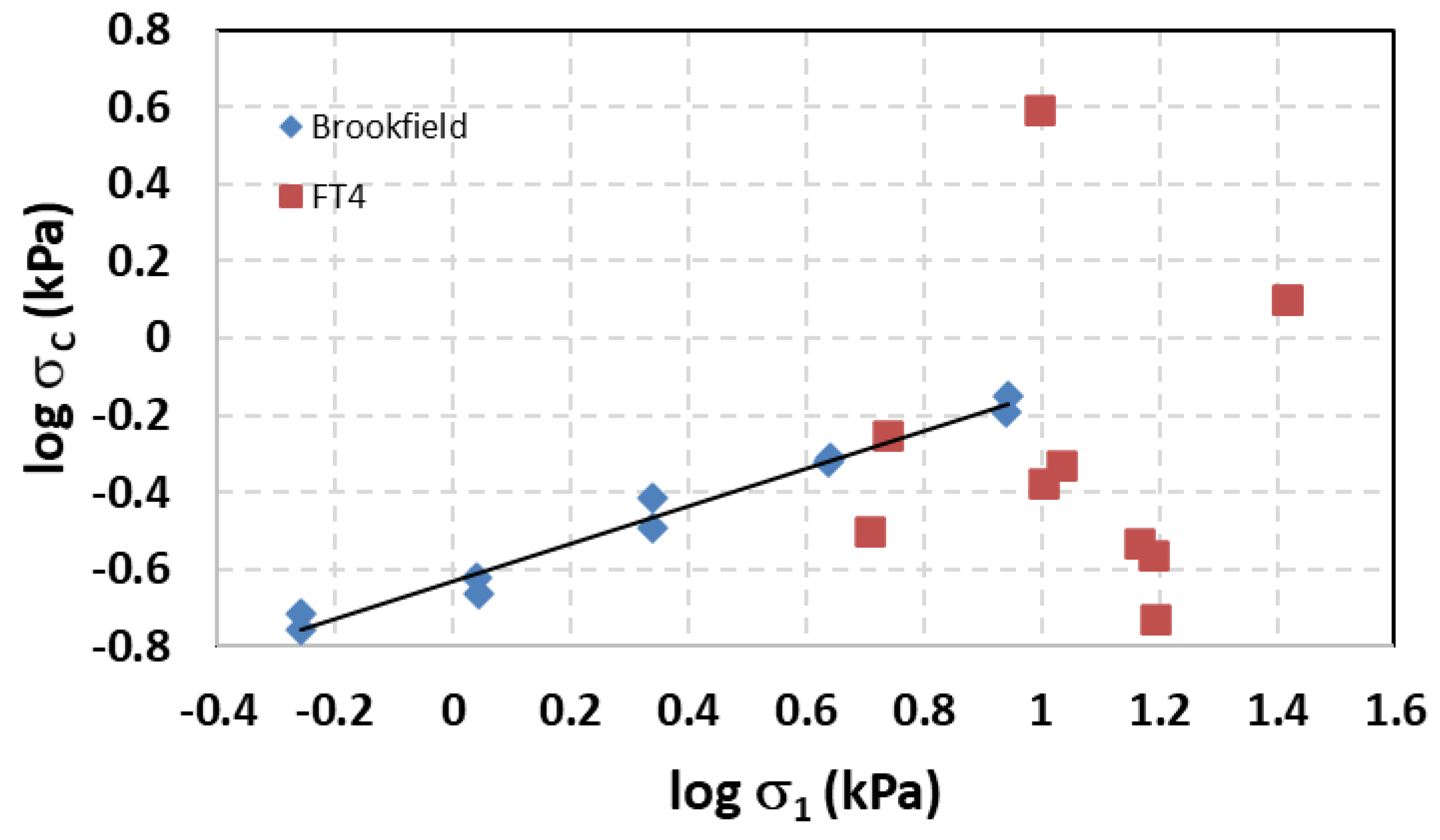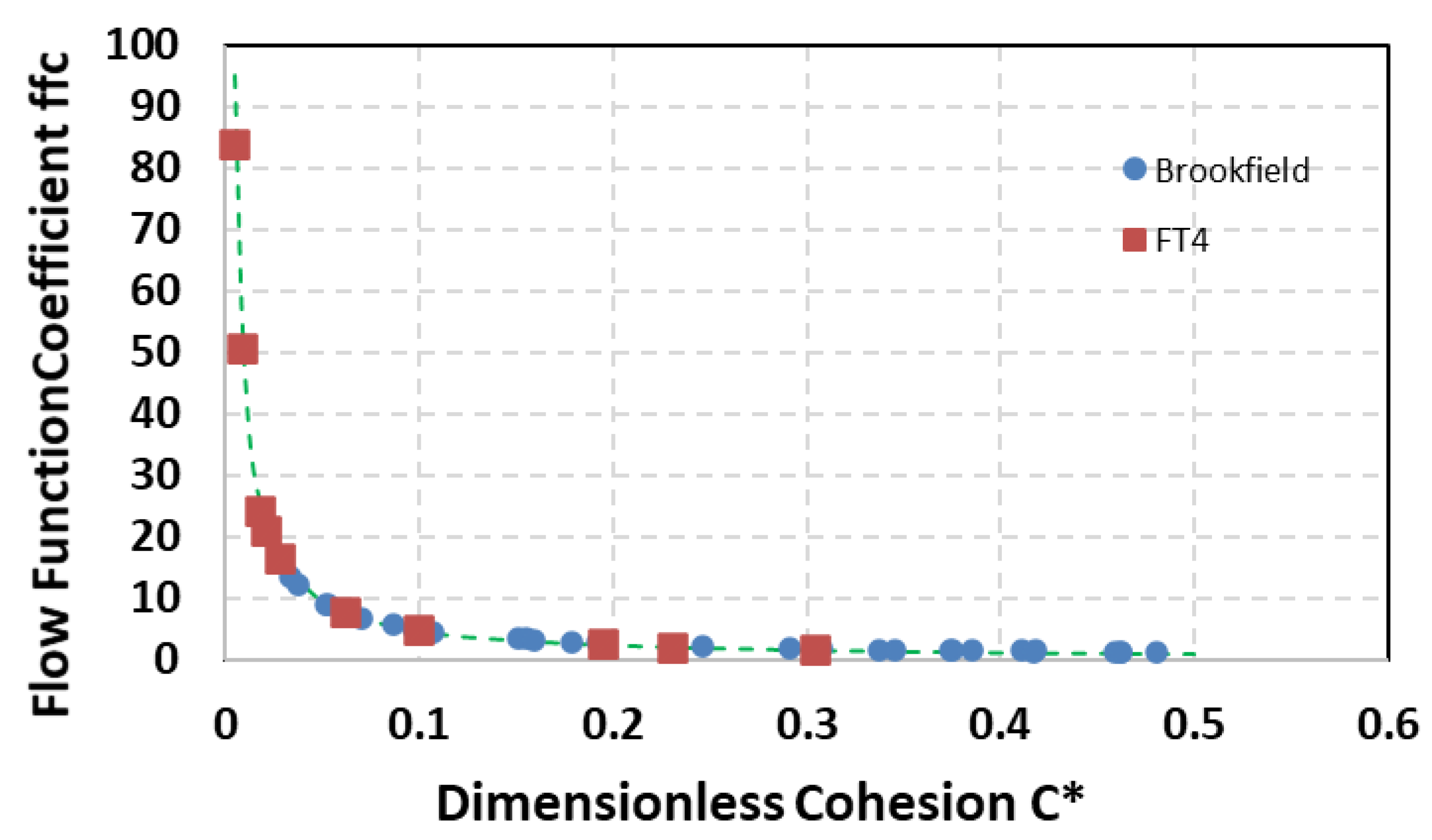Measuring the Flow Functions of Pharmaceutical Powders Using the Brookfield Powder Flow Tester and Freeman FT4
Abstract
:1. Introduction
2. Basic Theory Based on Jenike Shear Cell Tests
3. Methods and Materials
3.1. Freeman FT4 Powder Tester
3.2. Brookfield Powder Flow Tester
3.3. Test Materials
4. Results and Discussion
4.1. Measuring the Flow Function of CRM Limestone and Comparison with Akers
4.2. Measuring the Flow Functions of Common Pharmaceutical Excipients
- (i)
- Particle re-arrangement, where gaps between particles are reduced, air leaves the structure, and particles orientate themselves to minimize voidage and maximise bulk density. This usually happens in the initial stages of compaction.
- (ii)
- Plastic deformation, where the energy of compression is dissipated by particle surfaces softening and deforming irreversibly at contact points. This may lead to bonds being formed.
- (iii)
- Particle breakage, where the energy of compression causes particles to break and reduce in bulk density as in (i). This is prevalent when particles are hollow.
4.3. Normalisation of Data Using the Method of Wang et al.
5. Conclusions
Funding
Institutional Review Board Statement
Informed Consent Statement
Data Availability Statement
Conflicts of Interest
References
- Jenike, A.W. Gravity Flow of Bulk Solids; Utah University Engineering Experiment Station 123; University of Utah: Salt Lake City, UT, USA, 1962. [Google Scholar]
- Schwedes, J. Review on testers for measuring flow properties of bulk solids. Granul. Matter 2003, 5, 1–43. [Google Scholar] [CrossRef]
- Jaggi, V.; Leaper, M.C.; Ingham, A.J. Measuring the flow properties of small powder samples using an avalanche tester. Dry. Technol. 2016, 34, 723–728. [Google Scholar] [CrossRef] [Green Version]
- Calvert, G.; Curcic, N.; Redhead, C.; Ahmadian, H.; Owen, C.; Beckett, D.; Ghadiri, M. A new environmental bulk powder caking tester. Powder Technol. 2013, 249, 323–329. [Google Scholar] [CrossRef]
- Röck, M.; Ostendorf, M.; Schwedes, J. Development of a uniaxial caking tester. Chem. Eng. Technol. 2006, 29, 679–685. [Google Scholar] [CrossRef]
- Thakur, S.C.; Ahmadian, H.; Sun, J.; Ooi, J.Y. An experimental and numerical study of packing, compression and caking behaviour of detergent powders. Particuology 2014, 12, 2–12. [Google Scholar] [CrossRef]
- Leaper, M.C.; Leach, V.; Taylor, P.M.; Prime, D.C. A comparison of compacting and caking behaviour of carbonate-based washing powders. Dry. Technol. 2013, 31, 769–774. [Google Scholar] [CrossRef]
- Brockbank, K.; Armstrong, B.; Chandorkar, Y.; Freeman, T. Understanding powder caking as a consequence of a range of mechanisms by means of powder rheometry. Part. Sci. Technol. 2015, 33, 102–108. [Google Scholar] [CrossRef]
- Leaper, M.C.; Fisk, E.; Browne, R. Feasibility study to investigate caking in washing powder formulations using a Freeman FT4 powder rheometer. Part. Sci. Technol. 2018, 37, 1009–1014. [Google Scholar] [CrossRef] [Green Version]
- Freeman, R. Measuring the flow properties of consolidated, conditioned and aerated powders—A comparative study using a powder rheometer and a rotational shear cell. Powder Technol. 2007, 174, 25–33. [Google Scholar] [CrossRef]
- Leaper, M.C.; Ali, K.; Ingham, A.J. Comparing the dynamic flow properties and compaction properties of pharmaceutical powder mixtures. Chem. Eng. Technol. 2018, 41, 102–107. [Google Scholar] [CrossRef] [Green Version]
- Berry, R.J.; Bradley, M.S.A.; MacGregor, R.G. Brookfield powder flow tester—Results of round robin tests with CRM-116 limestone powder. Proc. IMechE Part E J. Process Mech. Eng. 2015, 229, 215–230. [Google Scholar] [CrossRef] [Green Version]
- Garg, V.; Mallick, S.S.; Garcia-Trinanes, P.; Berry, R.J. An investigation into the flowability of fine powders used in pharmaceutical industries. Powder Technol. 2018, 336, 375–382. [Google Scholar] [CrossRef]
- Leturia, M.; Benali, M.; Lagarde, S.; Ronga, I.; Saleh, K. Characterization of flow properties of cohesive powders: A comparative study of traditional and new testing methods. Powder Technol. 2014, 253, 406–423. [Google Scholar] [CrossRef]
- Akers, R.J. The Certification of a Limestone Powder for Jenike Shear Cell Testing (CRM116); Commission of the European Communities: Luxembourg, 1992; ISBN 92-826-3498-1. [Google Scholar]
- Wang, Y.; Koynov, S.; Glasser, B.J.; Muzzio, F.J. A method to analyze shear cell data of powders measured under different initial consolidation stresses. Powder Technol. 2016, 294, 105–112. [Google Scholar] [CrossRef] [Green Version]














| Powder | Source |
|---|---|
| CRM limestone | BCR-116, Sigma-Aldrich, Buchs, Switzerland |
| Calcium diphosphate | Acros, Geel, Belgium |
| Lactose | Adams Food Ingredients, Leek, UK |
| Maltodextrin | Paroxite Ltd., Macclesfield, UK. Maltrin M100 |
| Easytab | JRS Pharma, Rosenburg, Germany. |
| Brookfield PFT | Freeman FT4 | |||
|---|---|---|---|---|
| CRM limestone | R2 = 0.9992 | R2 = 0.9762 | ||
| Calcium phosphate | R2 = 0.9996 | R2 = 0.9253 | ||
| Lactose | R2 = 0.9983 | R2 = 0.9842 | ||
| Maltodextrin | R2 = 0.9630 | R2 = 0.7046 | ||
| Easytab | R2 = 0.9790 | R2 = 0.0341 | ||
Publisher’s Note: MDPI stays neutral with regard to jurisdictional claims in published maps and institutional affiliations. |
© 2021 by the author. Licensee MDPI, Basel, Switzerland. This article is an open access article distributed under the terms and conditions of the Creative Commons Attribution (CC BY) license (https://creativecommons.org/licenses/by/4.0/).
Share and Cite
Leaper, M.C. Measuring the Flow Functions of Pharmaceutical Powders Using the Brookfield Powder Flow Tester and Freeman FT4. Processes 2021, 9, 2032. https://doi.org/10.3390/pr9112032
Leaper MC. Measuring the Flow Functions of Pharmaceutical Powders Using the Brookfield Powder Flow Tester and Freeman FT4. Processes. 2021; 9(11):2032. https://doi.org/10.3390/pr9112032
Chicago/Turabian StyleLeaper, Mark Christopher. 2021. "Measuring the Flow Functions of Pharmaceutical Powders Using the Brookfield Powder Flow Tester and Freeman FT4" Processes 9, no. 11: 2032. https://doi.org/10.3390/pr9112032
APA StyleLeaper, M. C. (2021). Measuring the Flow Functions of Pharmaceutical Powders Using the Brookfield Powder Flow Tester and Freeman FT4. Processes, 9(11), 2032. https://doi.org/10.3390/pr9112032






